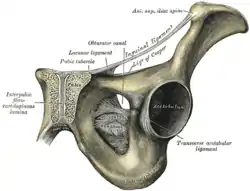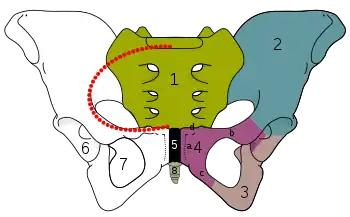| Pubic tubercle | |
|---|---|
 Pubic symphysis exposed by a coronal section. (Pubic tubercle labeled at upper left.) | |
 Pelvis. Pubic tubercle is 4d. | |
| Details | |
| Identifiers | |
| Latin | tuberculum pubicum ossis pubis |
| TA98 | A02.5.01.303 |
| TA2 | 1348 |
| FMA | 16953 |
| Anatomical terms of bone | |
The pubic tubercle is a prominent tubercle on the superior ramus of the pubis bone of the pelvis.
Structure
The pubic tubercle is a prominent forward-projecting tubercle on the upper border of the medial portion of the superior ramus of the pubis bone. The inguinal ligament attaches to it.[1] Part of the abdominal external oblique muscle inserts onto it.[1] The inferior epigastric artery passes between the pubic tubercle and the anterior superior iliac spine.[2] The pubic spine is a rough ridge that extends from the pubic tubercle to the upper border of the pubic symphysis.
Clinical significance
The pubic tubercle may be palpated.[3] It serves as a landmark for local anaesthetic of the genital branch of the genitofemoral nerve, which lies slightly lateral to the pubic tubercle.[3] This may also be used for the obturator nerve.[4]
Hernias
The pubic tubercle is a useful landmark for identifying hernias.[5] An inguinal hernia will lie anteromedial to the pubic tubercle.[5] A femoral hernia will lie inferolateral to the pubic tubercle.[5]
References
![]() This article incorporates text in the public domain from page 236 of the 20th edition of Gray's Anatomy (1918)
This article incorporates text in the public domain from page 236 of the 20th edition of Gray's Anatomy (1918)
- 1 2 Jacob, S. (January 1, 2008), Jacob, S. (ed.), "Chapter 4 - Abdomen", Human Anatomy, Churchill Livingstone, pp. 71–123, doi:10.1016/b978-0-443-10373-5.50007-5, ISBN 978-0-443-10373-5, retrieved January 22, 2021
- ↑ Garcia-Tsao, Guadalupe (January 1, 2018), Sanyal, Arun J.; Boyer, Thomas D.; Lindor, Keith D.; Terrault, Norah A. (eds.), "15 - Ascites and Hyponatremia", Zakim and Boyer's Hepatology (Seventh Edition), Philadelphia: Elsevier, pp. 220–232.e4, ISBN 978-0-323-37591-7, retrieved January 22, 2021
- 1 2 Narchi, Patrick; Singelyn, François; Paqueron, Xavier (January 1, 2008), Benzon, Honorio T.; Rathmell, James P.; Wu, Christopher L.; Turk, Dennis C. (eds.), "Chapter 49 - Truncal Blocks", Raj's Practical Management of Pain (Fourth Edition), Philadelphia: Mosby, pp. 905–915, ISBN 978-0-323-04184-3, retrieved January 21, 2021
- ↑ Candido, Kenneth D.; Benzon, Honorio T. (January 1, 2005), Benzon, Honorio T.; Raja, Srinivasa N.; Molloy, Robert E.; Liu, Spencer S. (eds.), "Chapter 76 - Lumbar Plexus, Femoral, Lateral Femoral Cutaneous, Obturator, Saphenous, and Fascia Iliaca Blocks", Essentials of Pain Medicine and Regional Anesthesia (Second Edition), Philadelphia: Churchill Livingstone, pp. 645–658, ISBN 978-0-443-06651-1, retrieved January 22, 2021
- 1 2 3 Jacob, S. (January 1, 2008), Jacob, S. (ed.), "Chapter 6 - Lower limb", Human Anatomy, Churchill Livingstone, pp. 135–179, doi:10.1016/b978-0-443-10373-5.50009-9, ISBN 978-0-443-10373-5, retrieved January 22, 2021
External links
- Atlas image: abdo_wall65 at the University of Michigan Health System - "The Coverings of the Inguinal Canal, External & Internal Oblique & Transversus Abdominis Removed"
- pelvis at The Anatomy Lesson by Wesley Norman (Georgetown University) (pelvissuperior2, pelvislateral, pelvisinside)
- Photo at nysora.com
- Photo of dissection at chula.ac.th
- Article and diagram at studentbmj.com